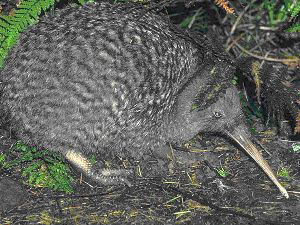Apteryx haastii (Great Spotted Kiwi)
Description: Small terrestrial birds with powerful legs and feet, tiny wings that are hidden by the plumage. The beak is long and slender, slightly decurved and has nostrils at the distal end rather than at the base, as in most birds. The bill base is covered with sensitive bristles, that are actually modified hairs. They complete lack a tail and the body ends with a small pygostyle. The legs are set far apart and give the birds a rather awkward, rolling gait. They have four toes, but the fourth is much reduced and faces backwards. The other three all end in a strong claw.
 Adult
Adult
Coat: The eyes are small and brown. The plumage is brown with chestnut tinge to the back, they have darker brown bands and the legs are grey with whitish claws. The bands of dark brown tend to be thicker than the base colour of lighter brown giving the bord a dark appearance overall. The bill is an creamy colour with a hint of pink.
Size: Total length 50-60cm, male bill 90-100mm, females bill 125-135mm.
Weight: Males: 1215-2610g, females: 1530-3270g.
Senses: Can swim surpirzingly well, crossing small streams and lakes by either wading or swimming acroos with ease.
They rely mostly on their sense of smell to locate prey, which is highly evolved, plus they have nostrils at the tip of their beak to get them closer to their prey.
They have poor eyesight and are all but blind in daylight.
Habitat: They occupy a variety of habitats, including tussock grassland, damp, mossy beach forests, dry, podocarp and hardwood forests and scrub-covered coastal areas. They live from sea-level up to 1200m, mainly occupying sub-alpine and alpine habitats at 700-1100m.
Range: Pairs hold ranges together, even marking them with feces, which is an unusal activity in birds but common in territorial mammal species. They become very attached to their home range and dig out many dens together on it, these are used as daytime sleeping hides and breeding tunnels.
Their burrows are usually about 9-15m wide and anything from 20-200m in length, each tunnel has only one opening.
The home range has been known to measure between 8-25 ha.
When defending their territory males call to mark their dominance. This may lead to an aggressive encounter with a neighbouring male who feels that his boundaries are being encroached upon. Such fights involve snorting and snapping leading to chases and kicking.
Distribution: South Island, mainly west of the main divide.
Status: Not globally threatened. There has been a marked decline in numbers since the Europeans colonized the Island. Declines are though to be caused by poison and traps set for possums. Also the introduction of mammalian predators, such as cats, dogs, mustelids and feral pigs.
Daily Rhythm: Nocturnal, leaving their den a few hours after dusk, they may wait anything from 15 to 90 minutes before leaving their den. They tend to be cautious about leaving the burrow, but once they do so they often go their separate ways to forage, meeting up again at dawn to rest.
Sometimes in the summer months they may remain active an hour after dawn.
Voice: Kiwis call frequently after dusk, usually reaching a peak of noise in the first 1-3 hours of darkeness. They call more in the breeding season and less when not breeding.
Kiwis adopt an upright possition when calling, with the neck and legs fully stretched and the bill pointing upwards.
Males generally call more than females, though both sexes call to defend their territory and may form duets in doing so. When mates call in this way, with one bird calling and the other calling in answer, a male from a neighbouring territory may join the duet. This may lead to an aggressive encounter with the two males. A fight will begin with the males snorting and snapping at one another.
When alarmed or angered, they growl, hiss and loudly snap their mandibles.
Males perform warbling whistles, and their calls can be heard several meters away. Females produce notes that are shorter, harsher and more gutteral than the males. Therefore kiwis can be located and sexed without even being seen, in fact it is much more common for kiwis to be heard and not seen.
Enemies: Feral pigs, cats, mustelids, dogs are the main enemies of the species, all of which are introduced mammals.
Prey: Mostly invertebrates, especially beetles larvae and earthworms, also takes large crickets, snails and spiders and freshwater crayfish.
Food and Feeding: Most prey is located with scent. They forage in soil and leaf-litter and when they smell prey they plunge their bill into the soil and lever it back and forth to open the hole. Crayfish are taken when they leave flooded streams, in this case the bill is used as a pick to pierce the shell, also used in snails. They may walk along trees that lean out from hillsides to get to higher feeding levels.
Grouping: Kwis live in pairs, they form a mating partenership for life and share a territory, excavate burrows together and breed together once a year.
Their young may live on their territory for some time. However they will live separately and sleep in separate burrows.
Breeding: Monogamous, laying in July-November (replacements clutches in November-January).
Gestation:
Litter Size:
Young Description:
Nest:
Young Care:
Sexual Maturity:
Longevity:
Back to Main Page
Back to Birds